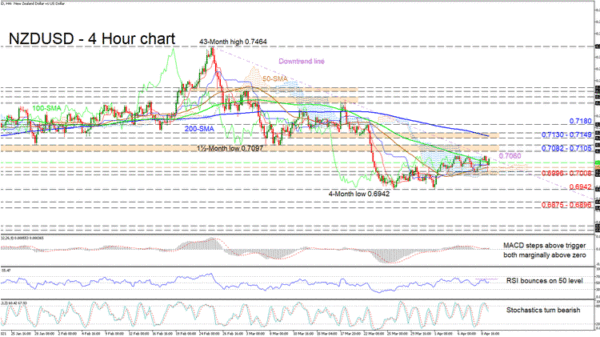NZDUSD has consolidated over the somewhat neutral Ichimoku cloud, after slightly improving from a recently formed floor at the 0.6942 level. The falling 200- and 100-period simple moving averages (SMAs) are shielding the bearish structure, while the climbing 50-period SMA is providing a footing for the price to recoup some lost ground.
Momentum seems to have evaporated and the merged and flattening Ichimoku lines are not transmitting any directional price preference. However, the short-term oscillators are relaying a mixed view on this narrative. The MACD is just above zero and its red trigger line and is endorsing positive sentiment, as is the RSI, which has rebounded a tad off the 50 level. On the contrary, the bearish stochastic oscillator is suggesting negative pressures may overpower any efforts to step above the diagonal line.
If the downtrend line pulled from the 43-month high of 0.7464 manages to annul buyers’ latest endeavours to progress to the upside, an initial support zone may operate between the 100- and 50-period SMAs at 0.7040 and 0.7022 respectively. For the slanted barrier to secure the pair’s negative trajectory, it will need to redirect the price beneath the above mentioned zone as well as the 0.6996-0.7008 minor base. Steering lower, the moulded four-month foundation at 0.6942 may try to impede negative pressures from pushing the price towards the November 2020 lows, forming a support region between 0.6875-0.6896.
Alternatively, a significant positive impetus is necessary to drive the price over the descending trend line at 0.7060. Should this occur, buyers may quickly be challenged by a key resistance section from 0.7082 to 0.7105. Nonetheless, even triumphing over this, a push past the 0.7130-0.7149 reinforced border and the 0.7180 high would be necessary to cement a positive outlook.
Summarizing, NZDUSD remains negatively skewed. It appears the required positive backing is currently not present to overcome the downtrend line and the 0.7082-0.7105 nearby boundary.


 Signal2forex.com - Best Forex robots and signals
Signal2forex.com - Best Forex robots and signals




